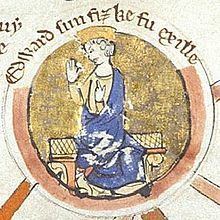Name Edward Exile | ||
 | ||
Died February 1057, London, United Kingdom Spouse Agatha, wife of Edward the Exile Children Edgar the AEtheling, Saint Margaret of Scotland, Cristina, daughter of Edward the Exile Grandchildren Edgar, King of Scotland, Matilda of Scotland Similar People Edgar the AEtheling, Edmund Ironside, Saint Margaret of Scotland, Malcolm III of Scotland, Edward the Confessor | ||
Parents Edmund Ironside, Ealdgyth | ||
Edward the Exile (1016 – 19 April 1057), also called Edward Ætheling, was the son of King Edmund Ironside and of Ealdgyth. He spent most of his life in exile in the Kingdom of Hungary following the defeat of his father by Canute the Great.
Contents
Exile
After the Danish conquest of England in 1016, Canute had Edward, said to be only a few months old, and his brother, Edmund, sent to the Swedish court of Olof Skötkonung (who was either Canute's half-brother or stepbrother), supposedly with instructions to have the children murdered. Instead, the two boys were secretly sent either to Kiev, where Olof's daughter Ingigerd was the Queen, or to Poland, where Canute's uncle Bolesław I Chrobry was duke. Later Edward made his way to Hungary, probably in the retinue of Ingigerd's son-in-law, András in 1046, whom he supported in his successful bid for the Hungarian throne.
Return
On hearing the news of his being alive, Edward the Confessor recalled him to England in 1056 and made him his heir. Edward offered the last chance of an undisputed succession within the Saxon royal house. News of Edward's existence came at a time when the old Anglo-Saxon monarchy, restored after a long period of Danish domination, was heading for catastrophe. The Confessor, personally devout but politically weak and without children, was unable to make an effective stand against the steady advance of the powerful and ambitious sons of Godwin, Earl of Wessex. From across the Channel William, Duke of Normandy, also had an eye on the succession. Edward the Exile appeared at just the right time. Approved by both king and by the Witan, the Council of the Realm, he offered a way out of the impasse, a counter both to the Godwinsons and to William, and one with a legitimacy that could not be readily challenged.
In 1054 King Edward sent Ealdred, Bishop of Worcester, to the court of the German emperor to set in train negotiations with the king of Hungary for the return of Edward the Exile. Ealdred was not at first successful, and Earl Harold's journey to Flanders, and possibly on to Germany and Hungary, in 1056 was probably undertaken to further negotiations. The Exile finally arrived in 1057 with his wife and children, but died within a few days on 19 April. He was buried in Old St Paul's Cathedral.
Family
Edward's wife was named Agatha, whose origins are disputed. Their children were:
Edward's grandchild Edith of Scotland, also called Matilda, married King Henry I of England, continuing the Anglo-Saxon line into the post-Conquest English monarchy.
Ancestors
Edward the Exile was a direct descendant of a line of Wessex kings dating back, at least on the pages of the Anglo-Saxon Chronicles, to the arrival of Cerdic of Wessex in 495AD, and from Alfred the Great in the English monarchs family tree. Of his more immediate ancestors, all four of Edward's male-line ancestors shown in the diagram below were Kings of England before Cnut the Great took the crown and sent Edward into exile.
